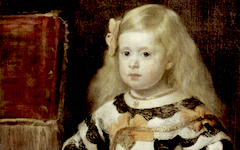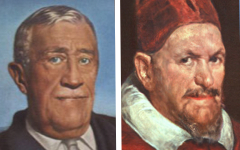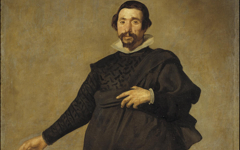Velazquez’s Old Woman Frying Eggs (1618)
This painting by the nineteen-year old Velazquez has never been interpreted. It is what it is, a closely observed study of a kitchen. Writers, starting with Velazquez's father-in-law, have called it a bodegón which translated means "a scene in a kitchen." We get nowhere.

Velazquez, Old Woman Frying Eggs (1618) National Gallery of Scotland, Edinburgh
Click image to enlarge.
To start making sense of an old woman frying eggs while a young boy approaches her holding a melon, we need to read prior reviews anyway. They can help because any "error", "inconsistency" or "fault" that past writers have seen is usually some feature of the actual scene that they themselves have not yet imagined.
Click next thumbnail to continue
In this case Dawson Carr expresses a common concern that "while the objects are rendered brilliantly, each was clearly studied independently and from a slightly different perspective so the whole has a disjointed quality..." Have greater faith in Velazquez. If it looks disjointed, he must have wanted it that way. Any painting by a major artist in which various motifs are seen from different perspectives usually means that part of the painting is a painting itself: a "painting" within the painting with "the artist" present.
Click next thumbnail to continue
Once noted, the woman's pose resembles an artist seated at her easel. Her far hand holding a spoon (instead of a paintbrush) is extended towards her "painting", the boy with a melon. She, the artist, is "real"; the boy "painted". That is why they seem unaware of each other's presence. Her near-hand also resembles an artist's, its thumb separated as though through the hole of a palette. It holds an egg which like paint on a palette represents the beginning. On that same literal level, the whole egg turns into a fried one; as allegory, paint is stirred to mix colors which then becomes a painting.
Click next thumbnail to continue
Once this is grasped, the lighting becomes suspect. Is it from the same direction on the woman as on the boy? To my eye they look different. The tools and implements, viewed from above, further resemble an artist's work-table with paintbrushes, flasks of fluids and a mortar for grinding pigments. As in a studio, they are within reach of the "artist". Whether or not the glass carafe seeming to "hover" above the one-pot stove is reminiscent of an alchemist's alembic is debatable but I would be surprised if a 1618 kitchen scene attempting to represent an artist's mind did not include a reference to alchemy.
Click next thumbnail to continue

Velazquez, Christ in the House of Martha and Mary (1618) National Gallery, London
Click image to enlarge.
Another painting from the same year and titled Christ in the House of Martha and Mary is well-known for the ambiguity of the little scene of Christ at upper right. Is it a serving hatch or a mirror on the wall? Or is it "a framed painting"? Given the age difference between the sisters, some also question the title.
See conclusion below
The presence again of a "work-table" in the foreground strongly suggests that the old woman (perhaps the same model) "paints" (by pointing at) the younger woman grinding pigments. In other words, Velazquez once again imagines himself as an old woman painting a picture of himself as a young woman in the process of painting. There is a long, little-known tradition in art of people pointing to represent artists painting. The finished "masterpiece" is a meeting with Christ. Picasso, a passionate admirer of Velazquez, would not have missed these studio allusions. He would have recognized that the young Velazquez had constructed an allegorical scene of his own wise and androgynous mind creating a painting, just as Velazquez did again decades later in Las Meninas, a composition of endless fascination for Picasso.
More Works by Velazquez
Notes:
Original Publication Date on EPPH: 15 Dec 2011. | Updated: 0. © Simon Abrahams. Articles on this site are the copyright of Simon Abrahams. To use copyrighted material in print or other media for purposes beyond 'fair use', you must obtain permission from the copyright owner. Websites may link to this page without permission (please do) but may not reproduce the material on their own site without crediting Simon Abrahams and EPPH.






